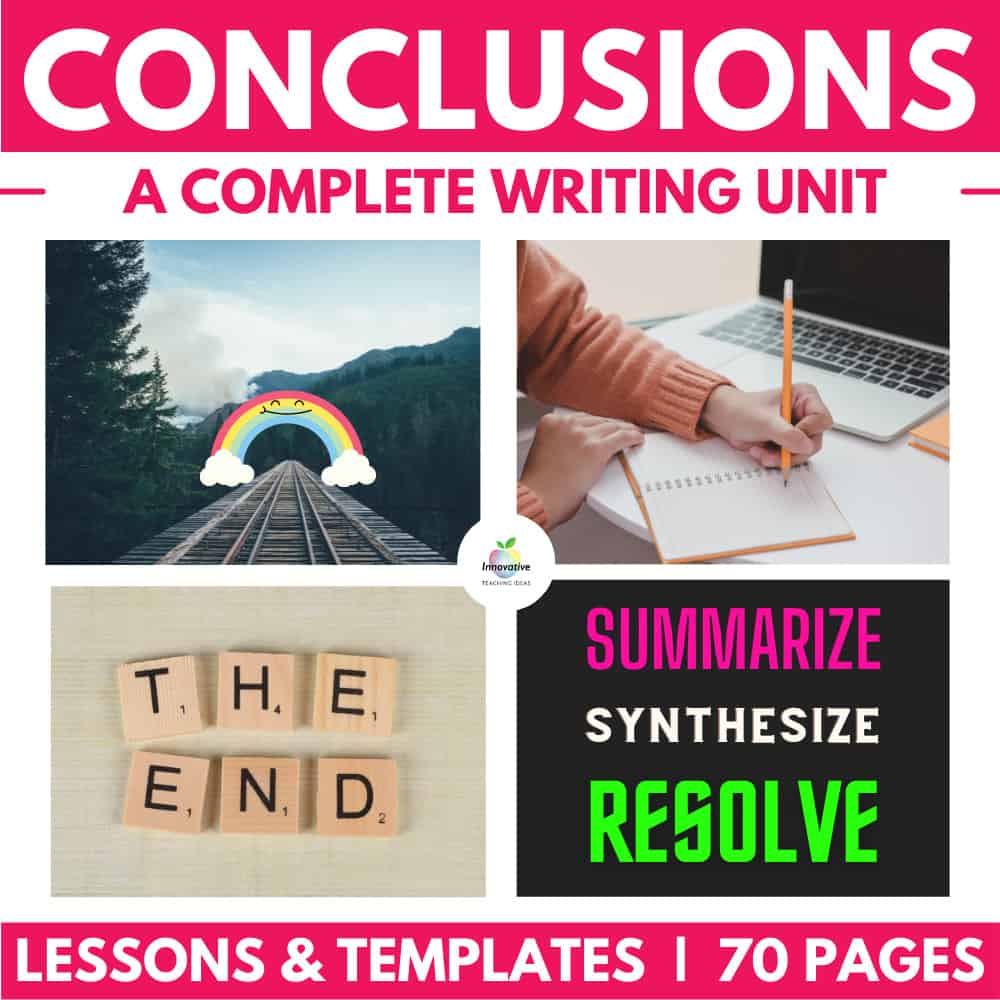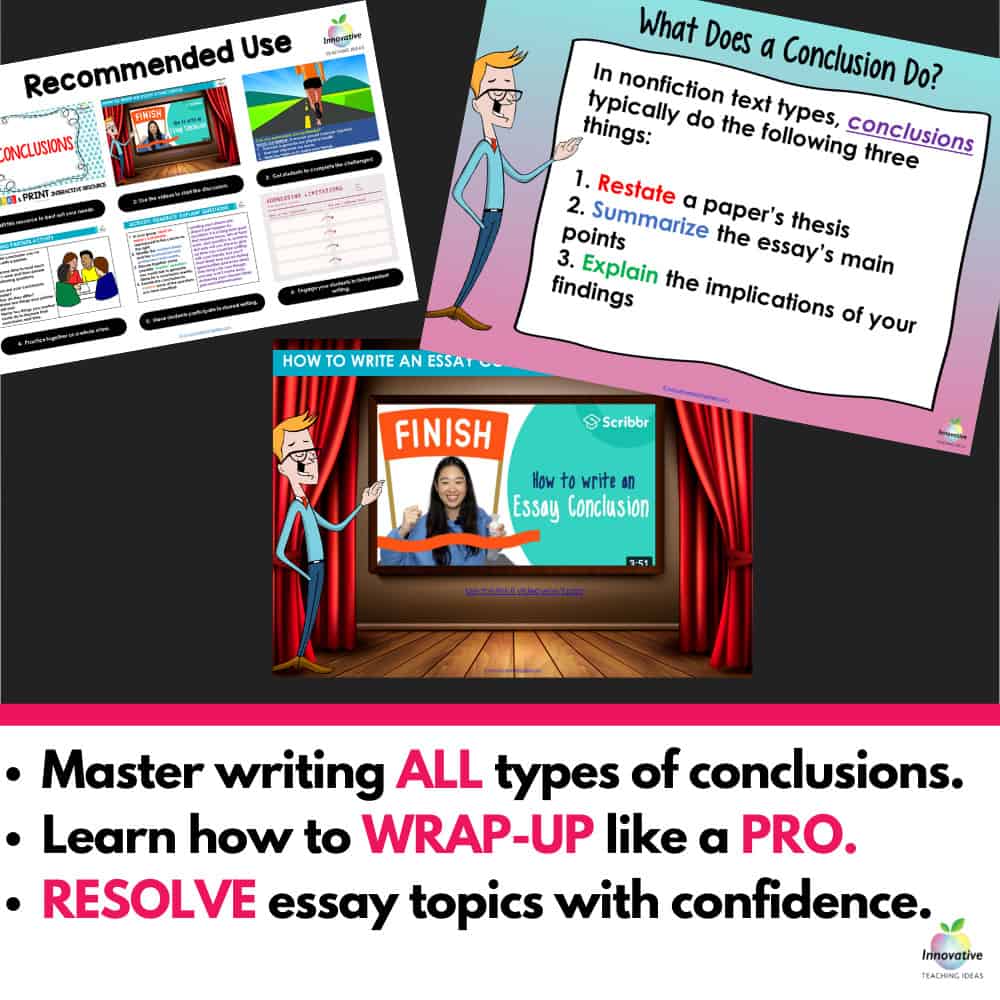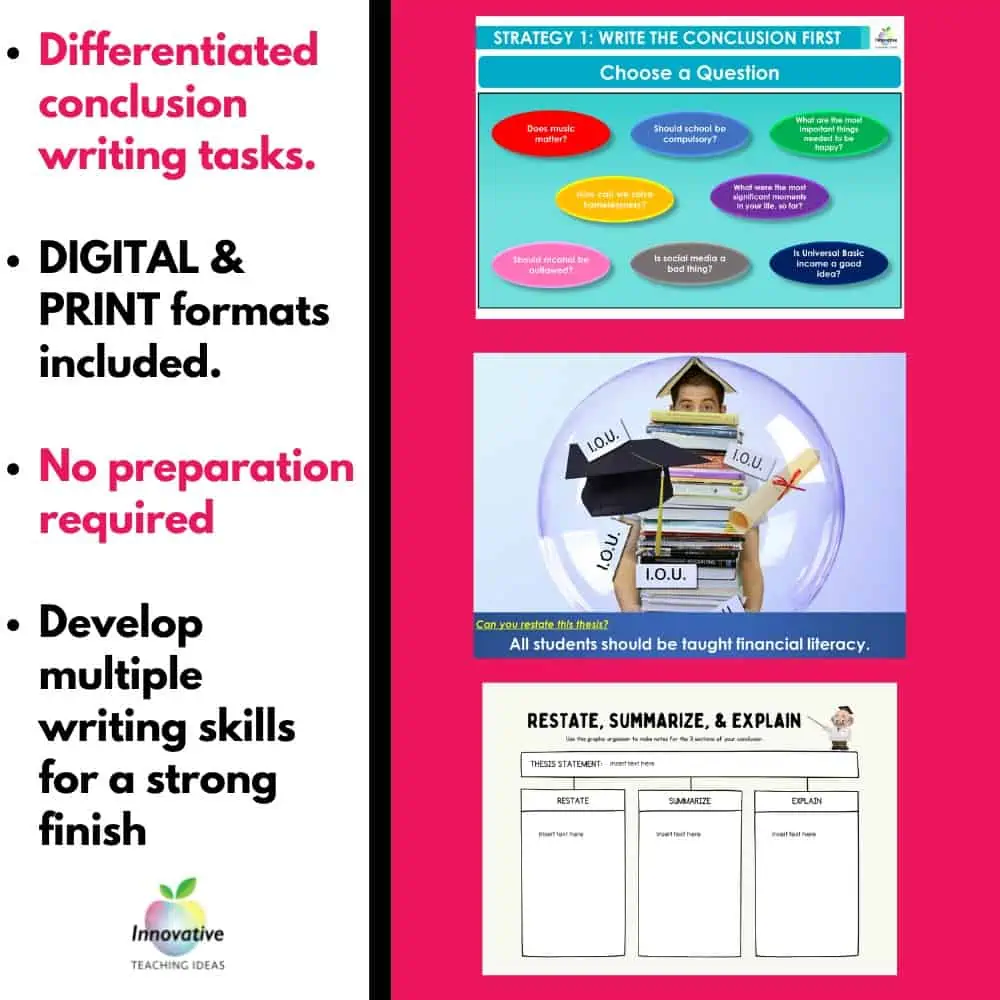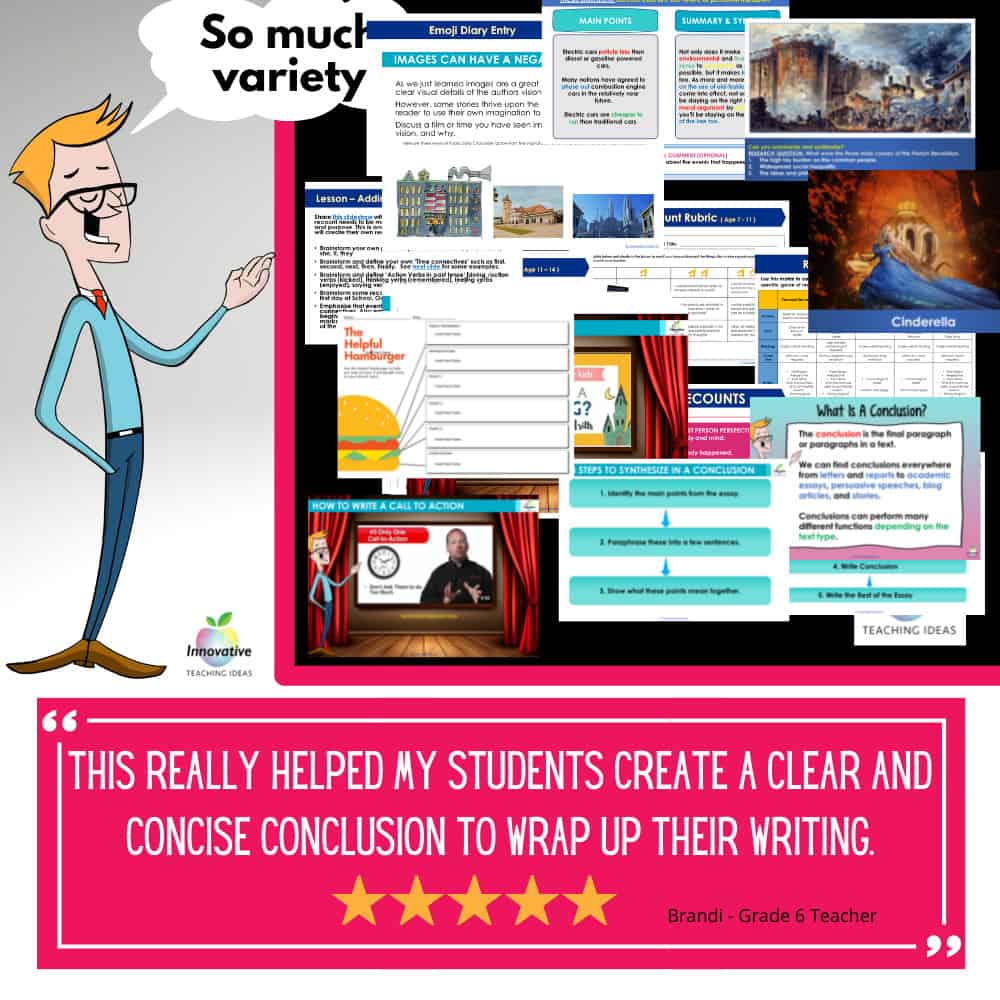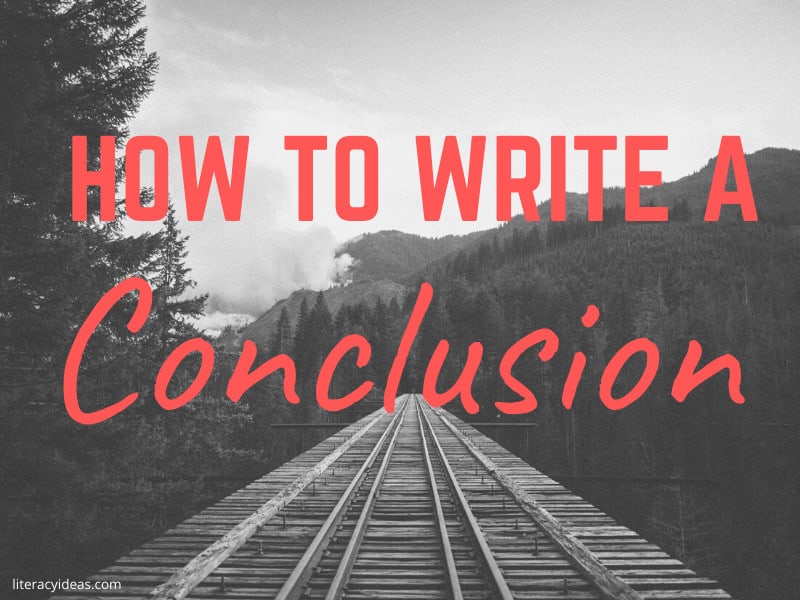
What is a Conclusion?
Before we learn how to write a conclusion, we need to determine what a conclusion is.
A conclusion is the final sentences or paragraph in a piece of writing that signifies the end of a text, event or process.
We can find conclusions everywhere, from narratives, letters and reports to persuasive essays and speeches.
Conclusions perform many functions, which we will examine throughout this article. Fundamentally, they wrap everything up and finish a piece of writing or a presentation.
Unfortunately, conclusions are often the most challenging section of a paper to write. They are the final words of the writer on the topic and, as a result, play a crucial part in the lasting impression the writing leaves on the reader.
For this reason, our students must take time to understand clearly the functions of a conclusion and how they work. Time spent mastering the art of conclusion writing will be time well spent.
A COMPLETE UNIT ON HOW TO WRITE A CONCLUSION
Teach your students to write POWERFUL CONCLUSIONS that put a bow on a great piece of writing. All too often, students struggle to conclude their writing. Stumbling, repeating themselves, or missing the opportunity to make a lasting impression.
This COMPLETE UNIT OF WORK will take your students from zero to hero over FIVE STRATEGIC LESSONS covered.
What is the Purpose of a Concluding Paragraph

Unfortunately, there is no one-size-fits-all formula we can teach our students that they can use to write any conclusion. Conclusions perform several functions, varying widely from paper to paper. Some of these functions include:
- Restates a paper’s thesis and explains why it’s important
- Synthesizes the essay’s arguments
- It opens up new questions
- Addresses limitations
- Makes a call to action.
Not all conclusions will perform each of these functions. How our students approach writing their conclusions will depend on several factors, including:
- The conventions of the writing genre
- The intended audience and their motivations
- The formality or informality of the paper
- The tone of the writing.
Now, let’s look at each of the functions of a conclusion one by one, along with a practice activity for each to give our students some hands-on practice.
1. A Concluding Paragraph Restates the Thesis and Explains Why
One of the most common errors in writing a conclusion is to use it to simply restate the thesis. Though this is widely taught, it isn’t enough.
The student should also explain why the argument made in their thesis is important. This involves considering the more widespread impact of the thesis and its supporting arguments.
The conclusion should inform the reader why the thesis matters by answering questions similar to the following:
- What are the wider societal implications of the thesis?
- Does the thesis challenge a widely accepted idea or belief?
- Does the thesis have significance for how things could be done in the future?
To write a conclusion in this vein, it is helpful for students to compose similar type questions relevant to their thesis, which they can then set out to answer.
These questions will vary widely according to the subject being written about and the genre being written in. Still, regardless, the conclusion should highlight the thesis’s significance to the wider world. This will bring context to the writing as a whole.
Example: In conclusion, this paper has argued that increasing access to education is essential for reducing poverty and promoting economic development. We have presented evidence from various studies showing the positive correlation between education and income and the role of education in fostering other developmental goals, such as improved health and reduced inequality. Restating the thesis, we can say that access to education is a fundamental human right and should be prioritized as a key development strategy to reduce poverty and promote sustainable economic growth. The evidence presented in this paper supports this argument, making a case for the importance of increasing access to education for the well-being of individuals and societies.
2. A CONCLUSION SYNTHESIZES THE PAPER’S ARGUMENTS
This is another very common function performed by the conclusion. While each body paragraph in the paper may correspond to a single specific argument in support of the central thesis, in the conclusion, the various strands of supporting arguments are woven into a coherent whole.
The conclusion is not the place to introduce new arguments or to simply list the arguments made in the body paragraphs. Instead, it provides a final opportunity for your students to drive home their main arguments one last time and make connections between them to reveal a coherent whole.
Often, a conclusion will combine functions of functions 1 and 2 by restating the thesis, synthesizing the arguments, and explaining the wider significance of the thesis.
When considering how to write a conclusion for an argumentative essay, remember to synthesize it.
Example: In conclusion, this paper has presented a thorough examination of the current state of renewable energy sources and their potential to combat climate change. Through an analysis of the economic and technical feasibility of various renewable energy options, we have shown that renewable energy is a viable and necessary solution to reducing carbon emissions. Additionally, we have highlighted the importance of government policies and investment in research and development to accelerate the adoption of renewable energy. Overall, this paper argues that renewable energy is a crucial step in the fight against climate change and must be prioritized to secure a sustainable future.
3. A CONCLUSION CAN OPEN UP NEW QUESTIONS
We often think of conclusions as drawing things to a close. But there’s another way of looking at things. Often, through the process of making various arguments in a piece of writing, new questions will emerge naturally.
This method is commonly encountered when exploring how to write a conclusion for a thesis.
This often occurs when the central thesis is set in a broader context. We can think of the progression of an essay as moving from a thesis statement through evermore specific arguments that support that initial thesis statement.
To open up new questions in the conclusion, the student should move from the specific to the more general, generating further possible lines of inquiry on the topic as they go. The effect of this type of conclusion is to spark the reader’s curiosity and further interest in the subject.
Example: In conclusion, our research has provided an in-depth examination of the effects of climate change on biodiversity. Our findings indicate that climate change is having a significant impact on the distribution and abundance of species. However, our research has also revealed that there are still many unanswered questions about the mechanisms driving these changes. For example, more research is needed to understand the role of different species interactions and the effects of climate change on specific ecosystem functions. We hope our research will serve as a foundation for further studies and inspire other researchers to continue investigating the complex relationship between climate change and biodiversity.
4. A CONCLUSION PARAGRAPH ADDRESSES THE LIMITATIONS
This method is often used in academic or scientific writing when considering how to write a conclusion for a report. In it, the student writer directly explores the weaknesses of their arguments.
It’s perhaps the bravest type of conclusion there is! Students need to be careful not to destroy their own thesis in the process. A sentence mentioning the limitation, quickly followed by a sentence or two addressing the problem, should be enough.
When done well, this strategy strengthens the impact of a paper by dealing head-on with potential criticisms and making strong counter-arguments in the process.
Example: In conclusion, our research provides valuable insights into the relationship between environmental factors and academic performance. However, it is important to note that our study has limitations. Firstly, the sample size was relatively small, and our results may not be generalizable to a larger population. Additionally, our study only considered one specific type of environmental factor and did not take into account other factors that may impact academic performance. Despite these limitations, our research provides a starting point for future studies in this area.
5. A CONCLUSION CAN OFFER A CALL TO ACTION

In a call-to-action type conclusion, the writer compels the reader to take a desired action or perform a particular task. This type of conclusion aims to persuade the reader or listener to do something.
Call-to-action conclusions work in various genres, including presentations, speeches, advertisements, and persuasive essays.
There are various techniques students can use to inspire action in their conclusions, such as appeals to emotions, the use of strong imperatives, or appeals to the reader’s or the listener’s self-interest.
Example: In conclusion, our research highlights the importance of access to clean drinking water in developing countries. Our findings show that a lack of access to clean water can lead to serious health issues and negatively impact the economy. However, it is not enough to simply acknowledge this problem – action must be taken. We call on governments, non-profit organizations, and individuals to take action by investing in infrastructure and providing education on sanitation and hygiene. Together, we can work towards providing access to clean water for all, and, ultimately, improve the quality of life for people living in developing countries.
Tips for Writing a Strong Conclusion
As young writers, crafting a solid conclusion for your essay is essential to communicate your ideas effectively. A well-written conclusion can help to summarize your main points, provide closure to your argument, and leave a lasting impression on your reader. Here are ten tips for writing a strong conclusion to an essay for high school students:
- Restate the main idea of your essay. A good conclusion should summarize the main points of your essay and reiterate the main idea or thesis statement.
- Provide closure to your argument. Your conclusion should provide a sense of closure to your argument and tie up any loose ends.
- Emphasize the importance of your topic. Your conclusion should also emphasize the importance of the topic you have discussed and why it matters to your reader.
- Offer a call to action. Encourage your reader to take action or think more deeply about the issues you have discussed in your essay.
- Avoid introducing new information. Your conclusion should be a summary of your main points, not a place to introduce new information or ideas.
- Keep it simple. Avoid using complex phrases or convoluted language in your conclusion.
- Use a strong concluding sentence. Your last sentence should be a powerful statement that leaves a lasting impression on your reader.
- Avoid summarizing every point. You don’t have to summarize every point you made in the essay; pick the main and most important ones.
- Reflect on your essay’s meaning. Take a step back and reflect on the overall meaning of your essay and the message you want to convey to your reader.
- Revise and proofread. Revise and proofread your conclusion carefully to ensure it is clear, concise, and error-free.
By following these tips, you can write a strong conclusion that effectively communicates your ideas and leaves a lasting impression on your reader.
What shouldn’t a conclusion do?
So far, we’ve discussed some conclusion writing strategies by discussing things a good conclusion should do. Now, it’s time to look at some things a conclusion shouldn’t do.
The following list contains some of the most common mistakes students must avoid making in their conclusions. This list can help students troubleshoot their conclusions when they get stuck or run into problems.
1. Uses a Vague Thesis Statement
If the student struggles to make a powerful impact in their conclusion, it may be because their thesis statement is too vague.
If this is the case, they messed up long ago.
The first time the reader sees the thesis statement should be in the introduction. Because all arguments stem from that statement, a comprehensive rewrite of the entire paper will most likely be needed.
2. Opens with a Clichéd Phrase
When students begin to learn to write conclusions, they often learn some stock phrases to help kickstart their writing. Phrases such as ‘in conclusion’ or ‘to conclude’ can be useful as prompts to get students quickly into the meat of their writing. However, overuse of such stock phrases can leave the writing feeling mechanical.
Ultimately, we want more for our students. If one of the purposes of a conclusion is to make a powerful impact on the reader, we must encourage our students to be creative and bold in their writing.
3. Doubts the Thesis
In the first part of this article, we briefly discussed the idea of addressing the limitations of the thesis and supporting arguments. This can be an effective strategy for students, but it can also be risky. The student needs to ensure they don’t undermine their stance.
When students use this strategy, ensure they understand that addressing limitations is not the same thing as apologizing for the position held. A good conclusion is impossible without the writer actually concluding something; conclusions should end with a strong statement.
4. Contains Irrelevancies
Students must ensure that every piece of information in their essay or article is relevant to the topic and thesis.
One of the most common mistakes students make is failing to ‘kill their babies’. That is, they go off on a tangent in their writing but are reluctant to remove the offending sentences in the editing process.
Often this happens because the student doesn’t want to throw out something they spent time writing, even if it’s utterly irrelevant to the topic they’re writing about.
At other times, students fail to be merciless in their editing because they’re waffling to reach an assigned word count.
In this case, it’s important to remind students that to the seasoned eye of a teacher or examiner, any puff and padding in their writing is obvious.
5. Fails to Address the Why?
As an article or a paper draws to a close, it’s essential that the reader feels the time they spent reading was time well invested. To achieve this, the student must answer the why? question satisfactorily. Students should make sure their readers leave their writing feeling like they have learned something of value, are inspired to take action or have new questions to research and answer.
Drawing the Curtains on Our Work on Conclusions
We’ve covered a lot of ground in our article on conclusions. We’ve looked at strategies and techniques our students can use to hone their conclusion-writing skills.

Now, it’s up to us as teachers to create opportunities for our students to perfect their understanding and ability to use these strategies and techniques in their writing.
While the ideas above will go a long way to ensuring your students are capable of composing well-written conclusions, with time and practice, they’ll develop their own style and approach to the conclusion conundrum – and surely there can be no more fitting conclusion than that!
Conclusion Writing Teaching Strategies and Activities
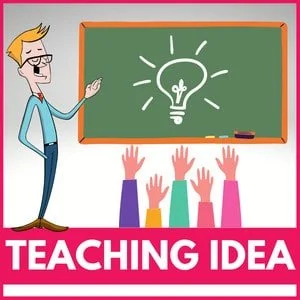
Practice Activity: Connect to the Wider World: To practice this, provide the students with a copy of a well-written essay suited to their level but with the concluding paragraph snipped out. Challenge the students to first identify the thesis statement, it should be in the essay’s introduction, and then to write a conclusion that connects that thesis to the wider world by explaining why it matters.

Practice Activity: Write the Conclusion First: Sometimes, it’s helpful for students to think of the conclusion as the destination their writing is headed for. The next time your students have completed an outline for an essay, instruct them to write the conclusion first. In it, they should explore the reasons for their thesis and its wider significance and synthesize their arguments. This gives the students a clear focus for the preceding introduction and body paragraphs and gives their writing a clear direction to work towards.

Practice Activity: Shift Perspective: For many students, writing this style of conclusion will require a shift in their understanding of the purpose of a conclusion. One good way to begin to shift that perspective is to encourage students to rewrite conclusions they’ve written previously in old essays. For example, they might shift the focus of a conclusion from a local significance to global significance or from historical significance to contemporary significance.

Practice Activity: Poke the Weak Points
Students take a conclusion they have written already, such as one written for a previous activity. Then, set the students the task of rewriting the conclusion to address any limitations of the supporting arguments. To do this, students need to ask themselves:
- What aspects of my arguments are open to contradiction?
- How can I address those contradictions?

Practice Activity: Blog It!: Blogs often use calls to action in the conclusions of their informational articles. Set your students the task of identifying several blogs on subjects that interest them. Students may benefit from doing this activity in groups.
Once they’ve identified some suitable websites, instruct the students to look at the conclusion of some of the articles.
- Can they identify any calls to action there?
- How do the writers introduce their calls to action?
- What techniques does the writer use to motivate the reader?
Challenge students to identify as many different motivational techniques and strategies as possible and then make a list that they can then share with the class.
When students have become good at identifying calls to action and the various motivational techniques and strategies, they can then write a blog article on a subject that interests them, making sure to include a call to action in their conclusion.
A COMPLETE TEACHING UNIT ON PERSUASIVE WRITING SKILLS
Teach your students to produce writing that PERSUADES and INFLUENCES thinking with this HUGE writing guide bundle covering: ⭐ Persuasive Texts / Essays ⭐ Expository Essays⭐ Argumentative Essays⭐ Discussions.
A complete 140 PAGE unit of work on persuasive texts for teachers and students. No preparation is required.



